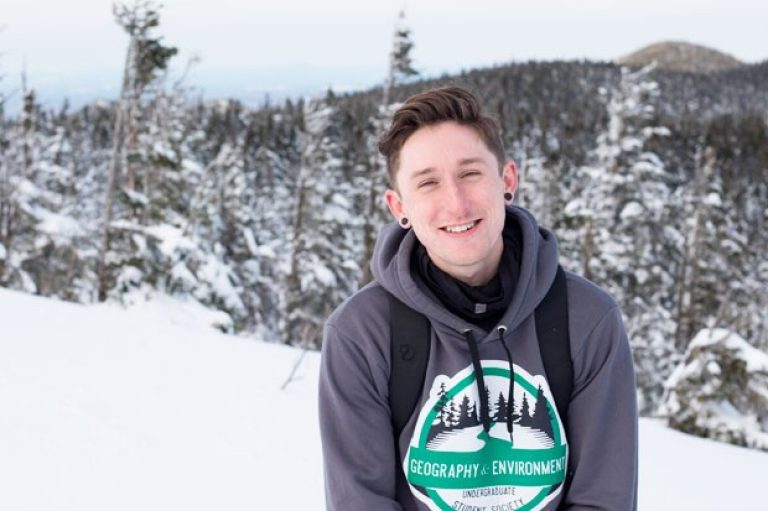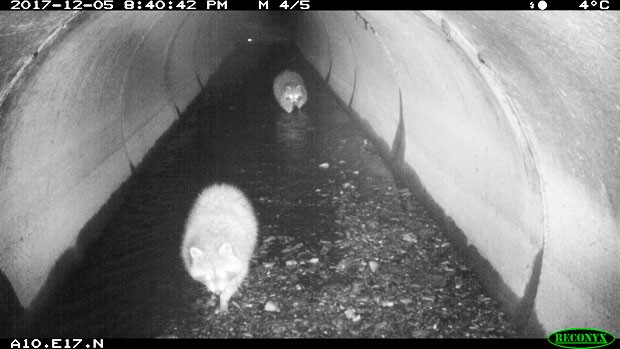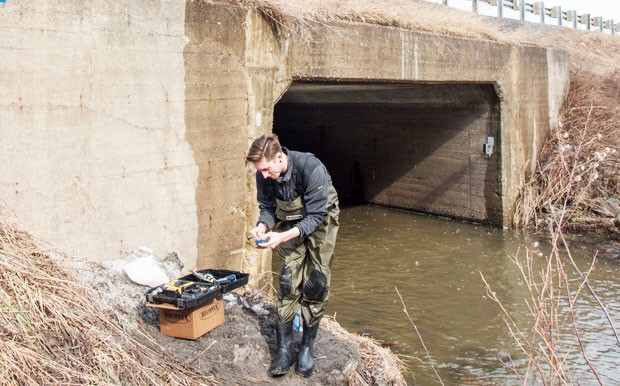University researcher studies how mammals navigate under and over Quebec’s busy highways

If you ever find yourself at the end of a drainage culvert, there’s a chance you’ll see Benjamin Brunen crawling out of it.
The graduate student in Concordia’s Master's in Geography, Urban and Enviromental Studies program often goes underneath highways to collect motion-sensing camera footage of animals using the culverts.
Under the supervision of Jochen Jaeger, associate professor in the Department of Geography, Planning and Environment, Brunen is beginning the fieldwork stage of his degree this spring. His research focuses on the effects Quebec's Highway 10 has on wildlife movement and the role that ecological corridors play in the study area. These linear parcels of land act as a bridge connecting two larger areas of a species’ habitat.
Often wading through up to a metre of water, Brunen collects memory cards from each one of his cameras to check the footage, before replacing them with new ones. When his study reaches its peak, he'll be filming approximately 30 sites.
Brunen, who is also a student member of the Quebec Centre for Biodiversity Science and junior associate member of the Loyola Sustainability Research Centre at Concordia, will combine his footage with other data to get an idea of how many animals are using the drainage culverts.

Our work can be applied anywhere there are roads
How does this specific image (above) relate to your research at Concordia?
This is an image from a trail camera I have set up in a drainage culvert in my study area. We're trying to determine how many animals of each species use these structures to successfully cross under, rather than over, the highway.
We also want to know how effective these structures are for small to medium-sized mammals. To achieve those two goals, we'll set up track boxes to collect animal footprints outside the drainage culverts and compare the imprints with those found inside. Together with the trail camera footage, we’ll create a performance index for each drainage culvert, showing how many animals that come to the area use it to get to the other side of the highway.
We're then going to compare areas of the highway that are within and outside the ecological corridors to determine if animals are more active along the corridors.
What is the hoped-for result of your project? And what impact could you see it having on people's lives?
I hope to be able to demonstrate that there is a relationship between animal activity in crossing structures — as well as through roadkill on the road surface — and the presence of ecological corridors. This could generate recommendations for decision-makers, and provide animals with a better chance at getting to their habitat on the other side of the road.
Fences may be needed to guide the animals towards the crossing structures and to prevent them from moving onto the road surface. This would also increase traffic safety.
What are some of the major challenges you face in your research? What are some of the key areas where your work could be applied?
One of the biggest challenges is that people tend to not take small and medium-sized mammals seriously when considering the impact that roads have on these animals’ movement patterns and population viability.
This is mostly because, when compared to a moose, hitting a weasel with your car isn't going to cause you many problems as a motorist. Accordingly, there isn't as much concern about driver safety when thinking about the small mammals.
Our work can be applied anywhere there are roads, so pretty much anywhere on the planet! Many new roads are being constructed worldwide right now, so this kind of research will be even more important in the future if we want to be serious about preventing accelerated biodiversity loss.

What person, experience or moment in time first inspired you to study this subject and get involved in the field?
It is 100 per cent thanks to my parents and their constant encouragement to pick something I love and pursue it as a career. My dad always says, "science is our friend!" I guess that sort of stuck with me.
I've loved animals since I was a little kid. My mom and I rescued an abandoned baby crow when I was a child and raised it until it was big enough to fly away and do adult crow things. I was able to get up close and personal with animals from an early age. I'm beyond excited to be doing research that could truly help wildlife populations one day!
How can interested STEM students get involved in this line of research? What advice would you give them?
Ecology is a growing field and most professors and labs — like ours — are always looking for new students to take on exciting projects. I recommend contacting a professor who is involved in research you find interesting and offering to help out! Start by taking a look at some of their papers, which you can usually find on their websites.
What do you like best about being at Concordia?
I love how approachable everyone is at Concordia, from the students to the professors. In my five years studying here, I've had nothing but positive experiences.
Within the Department of Geography, Planning and Environment, the diversity of research taking place is amazing, which is an aspect I really like. Everyone's work is totally different.
Are there any partners, agencies or other funding/support attached to your research?
My research is in direct collaboration with Appalachian Corridor, a non-profit conservation organization focused on protecting natural landscapes and their connectivity in the Appalachian region of southern Quebec.
Our lab has also been funded by the Quebec Ministry of Transport, Sustainable Mobility and Transport Electrification, the Nature Conservancy of Canada, and Mitacs.
Learn more about Concordia’s Department of Geography, Planning and Environment.


